精益企业 - 从组织的角度: 集成精益,敏捷,DevOPS等
Lean Enterprise (精益企业)是指一个产品系列价值流的不同部门同心协力消除浪费,并且按照顾客要求,来拉动生产。本文主要基于Scaled Agile, Inc. (SAI)公司的SAFe的框架(SAFe for Lean Enterprises)向你介绍精益企业的7个核心,并站在更高的视野层级上看敏捷和devops的位置,可以给你更多的启发。@pdai
精益企业全局
Lean Enterprise (精益企业):一个产品系列价值流的不同部门同心协力消除浪费,并且按照顾客要求,来拉动生产。这个阶段性任务一结束,整个企业立即分析结果,并启动下一个改善计划。
精益企业的提出
精益企业的提出是建立在精益生产的基础之上的。1990年,以美国MIT学者詹姆斯、丹尼尔为首的研究小组在全面研究了日本丰田生产方式并系统总结了该方式在其它国家应用情况的基础上,提出了一种新的生产管理理论——精益生产(Lean Production)在其研究成果之一的《改变世界的机器》一书中,他们对精益生产为什么能够显著改善企业经营业绩和提高企业竞争能力进行了详尽的阐述和充分的论证,指出了精益生产是一种能够广泛地应用于世界各国制造业、非常卓越的生产经营方式。随后短短几年,精益生产就作为一种有效的管理思维和行为模式风靡整个欧美和其他国家的企业界。
此后,精益生产理论的创始人詹姆斯、丹尼尔等人在协助欧美一些国家的企业实施精益生产的过程中又进一步认识到:尽管应用精益生产能够给某些公司或某专门化活动带来巨大的改进,但这些单个公司或单项活动的改进远非精益生产所要达到的目的。如果能将这些个体的改进或突破扩展至某类产品价值创造过程的各个环节,使之相互连接,形成包括产品开发、制造、销售和服务的价值创造流,无疑会极大地提高整个产品生产过程的绩效,并且使消费者获得的价值最大化。如何使产品价值创造过程的所有环节有机地连接起来,则需要建立一种新的企业组织模式——精益企业(Lean Enterprise)。
SAFe
国外有家公司叫Scaled Agile, Inc. (SAI),它推出了SAFe的框架(SAFe for Lean Enterprises)是全球领先的业务敏捷框架。SAFe将精益、敏捷和DevOps的力量集成到一个全面的操作系统中,通过更快、更可预测和更高质量地提供创新产品和服务,帮助企业在数字时代茁壮成长。如下内容来源于SAFe官方网站
SAFe的主要框架如下:
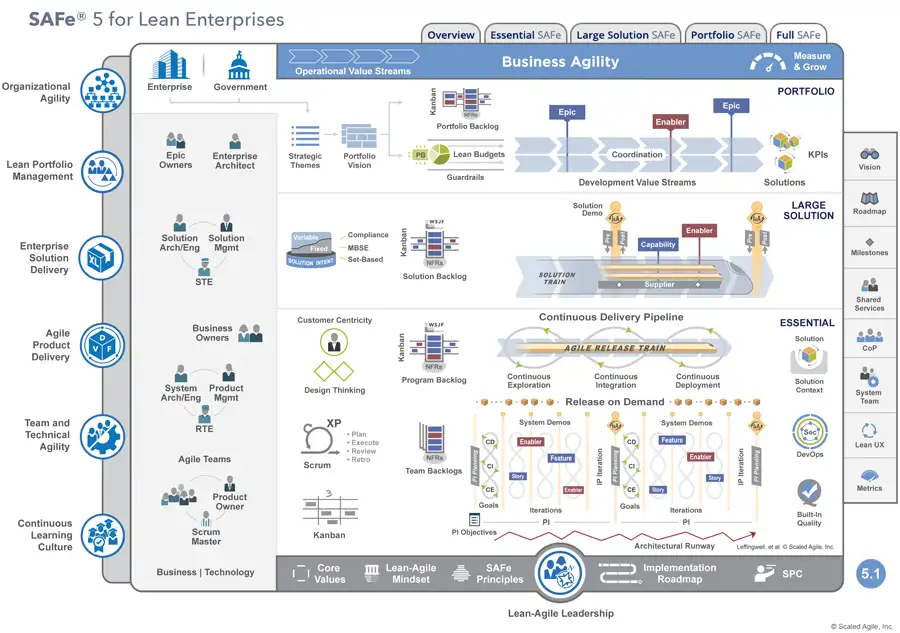
pdai:之所以介绍这个SAFe, 主要是站在更高的视野层级上看敏捷和devops的位置,希望可以给你更多的启发.
精益企业的7个核心
下图提供了SAFe的精益企业七项核心能力及其二十一个维度的简化视图,以实现业务敏捷性。所有能力的焦点都是客户, 精益敏捷领导是基础。
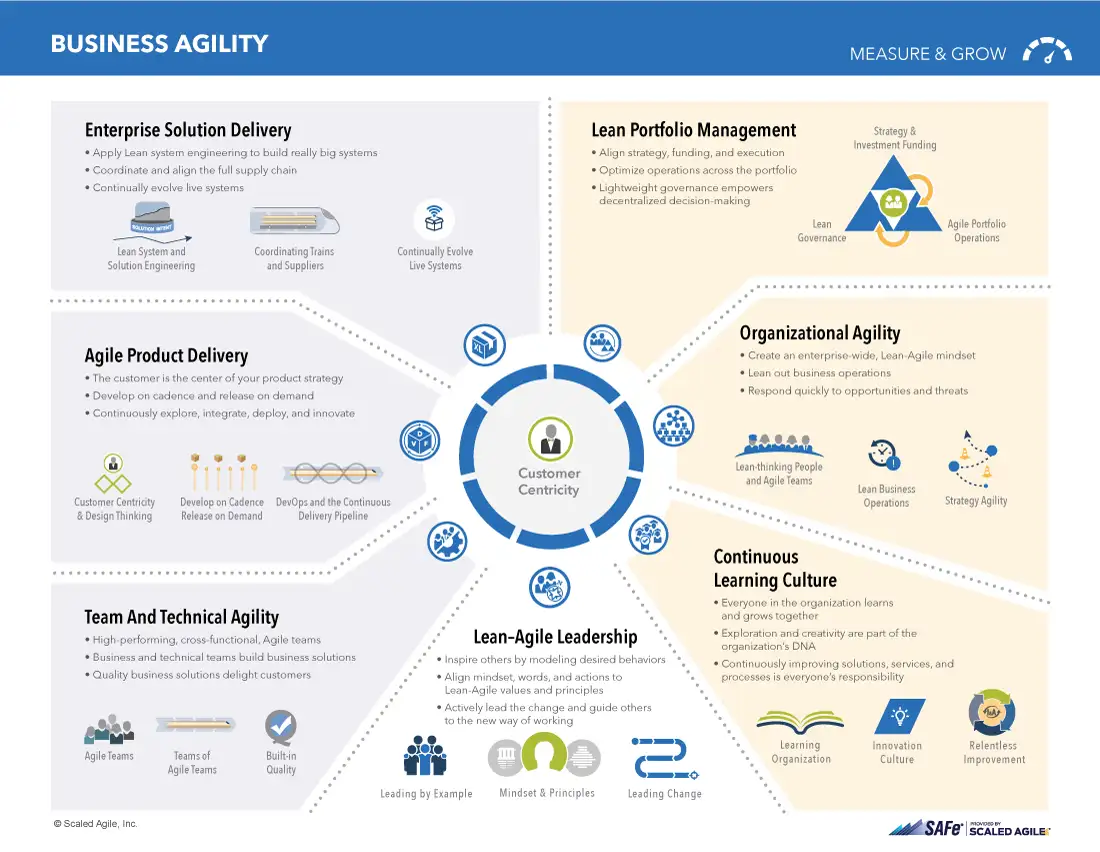
Team and Technical Agility
敏捷开发是业务敏捷的基石。团队和技术敏捷能力描述了高绩效敏捷团队和敏捷团队团队用于为客户创建高质量解决方案的关键技能和精益敏捷原则与实践。它由三个维度组成:
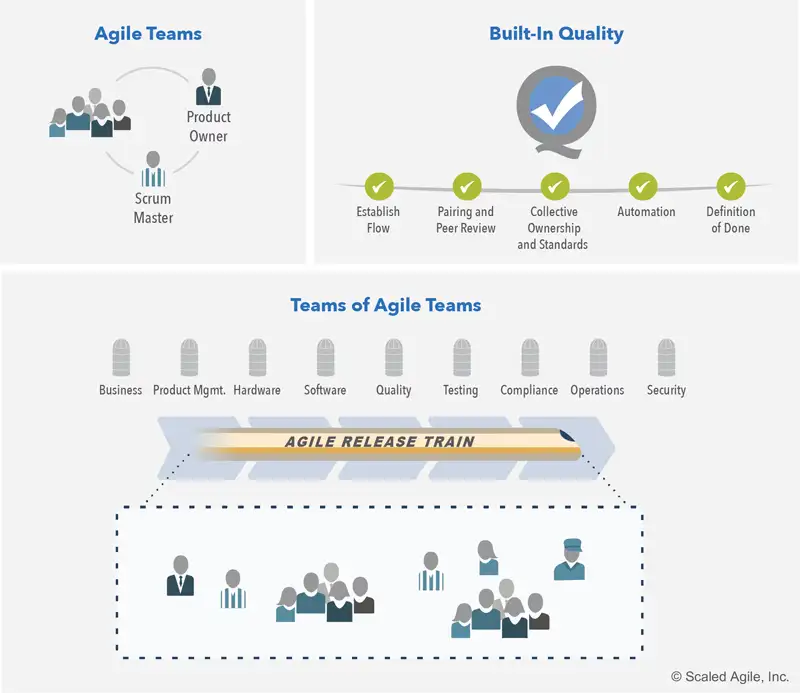
- Agile Teams – High-performing, cross-functional teams anchor the competency by applying effective Agile principles and practices.
- Team of Agile Teams – Agile teams operate within the context of a SAFe Agile Release Train (ART), a long-lived, team of Agile teams that provides a shared vision and direction and is ultimately responsible for delivering solution outcomes.
- Built-in Quality – All Agile teams apply defined Agile practices to create high-quality, well-designed solutions that support current and future business needs.
Agile Product Delivery
业务灵活性要求企业迅速提高其提供创新产品和服务的能力。可以肯定的是,企业正在为正确的客户在正确的时间创建正确的解决方案;他们必须在执行重点和客户重点之间取得平衡。这些能力相互支持,为持续的市场和服务领导创造机会。敏捷产品交付是一种以客户为中心的方法,用于定义、构建和向客户和用户发布一系列有价值的产品和服务。
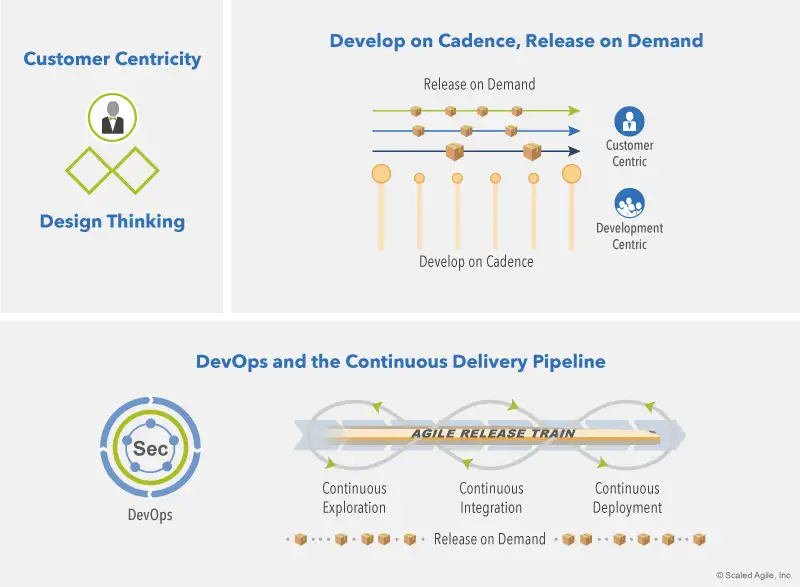
- Customer Centricity and Design Thinking – Customer centricity puts the customer at the center of every decision and uses design thinking to ensure the solution is desirable, feasible, viable, and sustainable. Develop on Cadence;
- Release on Demand – Developing on cadence helps manage the variability inherent in product development. Decoupling the release of value from that cadence ensures customers can get what they need when they need it.
- DevOps and the Continuous Delivery Pipeline – DevOps and the Continuous Delivery Pipeline creates the foundation that enables enterprises to release value, in whole or in part, at any time it’s needed.
Enterprise Solution Delivery
企业解决方案交付能力描述了如何将精益敏捷原则和实践应用于世界上最大和最复杂的软件应用程序、网络和网络物理系统的规范、开发、部署、操作和演化。
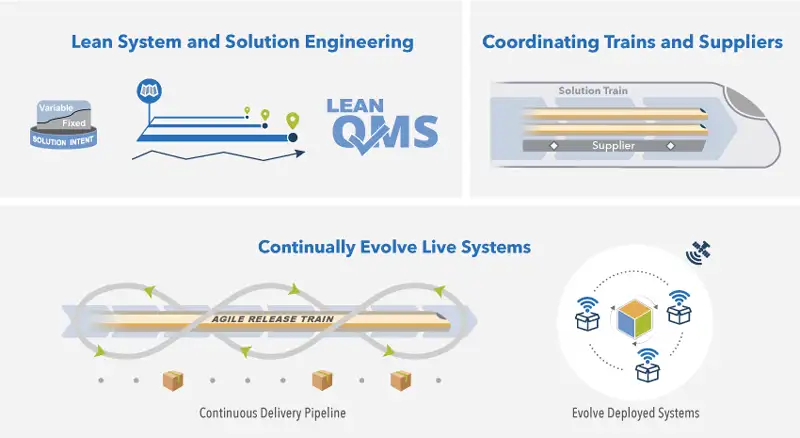
- Lean System and Solution Engineering applies Lean-Agile practices to align and coordinate all the activities necessary to specify, architect, design, implement, test, deploy, evolve, and ultimately decommission these systems.
- Coordinating Trains and Suppliers coordinates and aligns the extended set of value streams to a shared business and technology mission. It uses the coordinated Vision, Backlogs, and Roadmaps with common Program Increments (PI) and synchronization points.
- Continually Evolve Live Systems ensures both the development pipeline and the large systems themselves support continuous delivery of value, both during and after, release into the field.
Lean Portfolio Management
上述三种能力提供了构建和部署有意义的业务解决方案所需的技术实践。但它们都没有直接解决更重要的问题,即为什么需要这些解决方案,如何为它们提供资金和进行管理,以及需要哪些其他解决方案来实现完整的企业价值。为此,我们需要解决投资组合问题。然而,传统的投资组合管理方法并不是针对数字中断的影响而设计的。这些因素给企业施加了压力,使其在更高程度的不确定性下工作,但要更快地交付创新解决方案。项目组合管理方法必须现代化,以支持新的精益敏捷工作方式。精益投资组合管理能力通过应用精益和系统思维来协调战略和执行。如图7所示,它通过战略和投资融资、敏捷投资组合运营和精益治理三个协作来实现这一点。

- Strategy and Investment Funding ensures that the entire portfolio is aligned and funded to create and maintain the solutions needed to meet business targets. It requires the cooperation of Business Owners, portfolio stakeholders, technologists, and Enterprise Architects.
- Agile Portfolio Operations coordinates and supports decentralized program execution, enabling operational excellence. It requires the cooperation of the Agile Program Management Office/Lean-Agile Center of Excellence (APMO/LACE) and Communities of Practice (CoPs) for Release Train Engineers (RTEs) and Scrum Masters.
- Lean Governance manages spending, audit and compliance, forecasting expenses, and measurement. It requires the engagement of the Agile PMO/LACE, Business Owners, and Enterprise Architects.
Organizational Agility
即使具备上述能力,企业也必须能够快速改变,以应对当今快速发展的市场所带来的挑战和机遇。这需要比分层操作系统可能能够集合的更大的灵活性和适应性。我们再次求助于第二个操作系统。
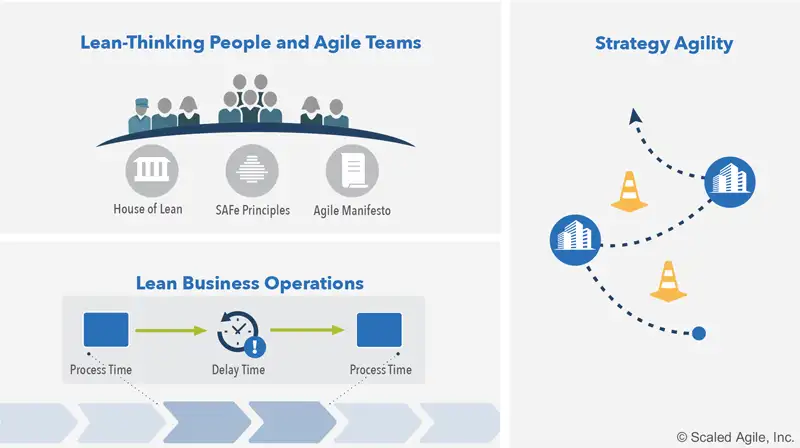
- Lean-Thinking People and Agile Teams – This state occurs when everyone involved in solution delivery is trained in Lean and Agile methods and embraces and embodies the values, principles, and practices.
- Lean Business Operations – Teams apply Lean principles to understand, map, and continuously improve the business processes that support the business’s products and services.
- Strategy Agility – This state occurs when the enterprise shows the ability and adaptability needed to sense the market and quickly change strategy when necessary continuously.
Continuous Learning Culture
为了满足持续学习、员工成长和流程改进的需求,持续学习文化能力描述了一系列价值观和实践,鼓励个人和整个企业不断提高知识、能力、绩效和创新。
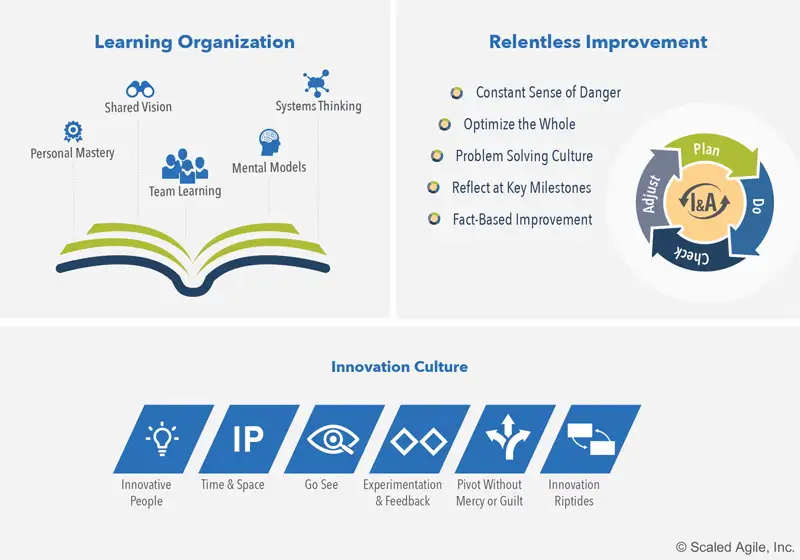
- Learning Organization – Employees at every level are learning and growing so that the organization can transform and adapt to an ever-changing world.
- Innovation Culture – Employees are encouraged and empowered to explore and implement creative ideas that enable future value delivery.
- Relentless Improvement – Every part of the enterprise focuses on continuously improving its solutions, products, and processes.
Lean-Agile Leadership
最后,我们认识到,一个组织的经理、执行官和其他领导者为精益敏捷开发的采用和成功以及对业务敏捷能力的掌握提供了最终负责的基础。只有他们才有权改变和持续改进管理工作执行方式的系统。只有他们才能创造一个鼓励高绩效敏捷团队蓬勃发展并创造价值的环境。因此,领导者必须将更精简的思维和操作方式内化并加以示范,以便团队成员能够从他们的榜样、指导和鼓励中学习。
如图所示,通过帮助领导者沿着三个维度发展,组织可以建立精益敏捷领导的核心能力。
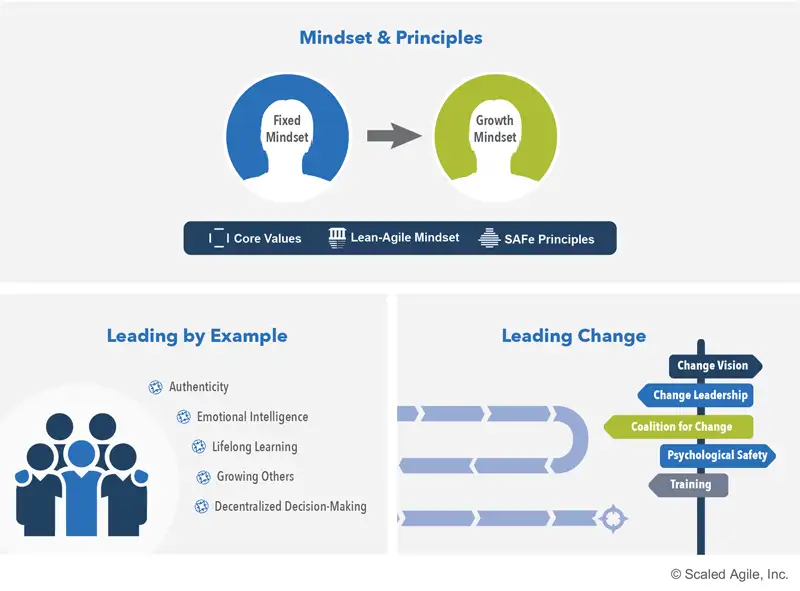
- Leading by Example – Leaders gain earned authority by modeling the desired behaviors for others to follow, inspiring them to incorporate the leader’s example into their development journey.
- Mindset and Principles – By embedding the Lean-Agile way of working in their beliefs, decisions, responses, and actions, leaders model the expected norm throughout the organization.
- Leading Change – Leaders lead (rather than support) the transformation by creating the environment, preparing the people, and providing the necessary resources to realize the desired outcomes.
参考文章
https://www.scaledagileframework.com/safe-for-lean-enterprises/
https://jiagoushi.pro/safe-lean-enterprises